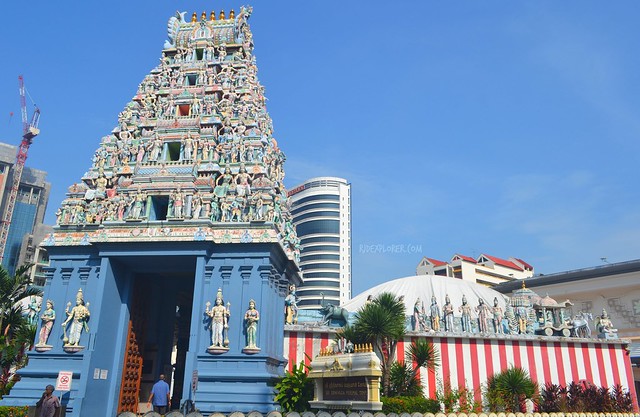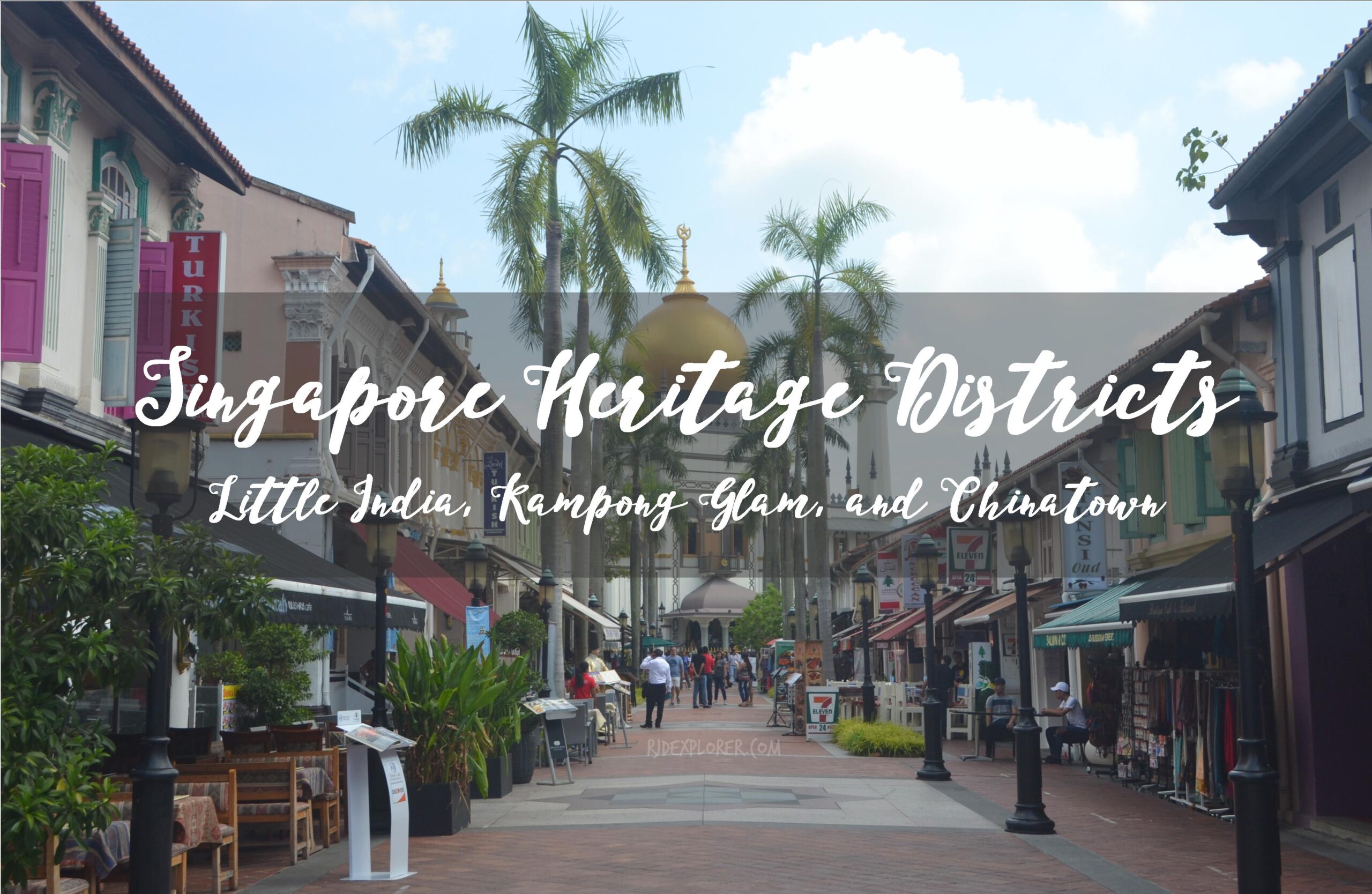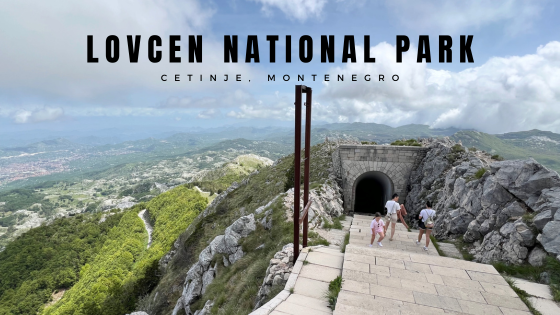For those who will use my Singapore itinerary, please prepare to endure long walks. I brought a pedometer with me and walking throughout the day was never an issue. On my last day in the country, I was able to cover three famous Singapore heritage districts. Little India, Kampong Glam, and Chinatown are believed to influence most of Singapore’s culture.

Sunday morning started with a short MRT ride from Chinatown to Little India. A muddled street welcomed me as I emerged from the subway. A group of Indian men choreographed their stint to bring their old man, on a wheelchair, to a higher platform. I left the scene when I learned that it might be insensitive staring at the brouhaha.
VIBRANT NEIGHBORHOOD OF LITTLE INDIA
Traversing some narrow and unblemished streets, I arrived in Sri Veeramakaliamman Temple. The part of the structure that first struck my interest was the temple’s spire. It is a pyramidal structure showcasing some Hindu deities in full colors. I couldn’t help myself staring at the front tower, Rajagopuram as they call it, as it stood out from the blue-hued horizon.

Going straight on Serangoon Road is another temple, Sri Srinivasa Perumal Temple. Its architectural design is similar to the first with a tower having an intricate and vibrant work of art. However, foreground of Sri Srinivasa Perumal is bigger. It was a day of worship so crowd of faithful was observed.
Apart from temples, you can also take sights of the colorful shophouses offering multitude of stuff from garments, gadgets, to groceries. If you’re looking forward to taste authentic Indian cuisine, Little India is definitely the best place to have some. Restaurants near Mustafa Center offer biryani, curry, and tandoori among others.

On Campbell Lane, bordered by Little India Arcade and Indian Heritage Center, are vendors selling fruits, flowers, and garlands made of Jasmine. Last destination I’ve checked in the neighborhood was the Masjid Abdul Gafoor. Tourists can enter the compound and I heard that visitors are also allowed inside the mosque. Just be sure to follow the dress code and other guidelines being imposed.
TRAILING THE HISTORIC KAMPONG GLAM
Nights before my visit to the Singapore heritage districts, a friend sent me a blog post that features Singapore street arts. And most items on the list are found in Kampong Glam. Before exciting myself on various bright graffiti arts, I made my way to Masjid Hajjah Fatimah. Based on a marker, the mosque was built between 1845 and 1846. It was founded by Hajjah Fatimah, who at a young age, married and widowed to a Bugis prince. In late 1830s, her home was raided twice by thieves but left unharmed. With this, she donated money and land for the building of the mosque.

What I like about Kampong Glam over Little India are the heritage markers that narrate the story behind these landmarks. This won’t compromise the story that travelers, without guides, should know about the place. Malay Heritage Center was once the residence of the Malay royalty in Singapore back in the late 1800s. The compound, in general, maintained its eminence with the well manicured lawn with several trees near the main building. There are booths on the side that serve as a stop for tourists to avail souvenirs and quick snacks.

On a nearby compound is another heritage site I discovered by chance. Gedung Kuning, or Yellow Mansion, because of its obvious wall paints. The very clear similarity of the mansion and the heritage center is the design, especially the porch. Mamanda, a restaurant offering Malaysian cuisine, now occupies the yellow mansion. Next site was the Sultan Mosque, also known as the Grand Mosque. Sultan Mosque plays a vital role for Muslims in Singapore. The religious structure serves as the hub for them to gather during the fasting month of Ramadan.
Dozens of tourists, with or without guides, were busy taking photos with the famous mosque on the background. Heat started to bug everyone so I decided to visit some booths selling souvenirs from key chains, shirts, and whatever item they could print the phrase “I Love Singapore”. The narrow street towards the mosque is also flanked by restaurants offering middle-eastern food.

At the end of the street is the famous Kampong Glam Café that is open until 2AM. Turning right on Baghdad Street will lead you to the famous Arab St. They consider the street, together with Haji Lane, as one of the hippest places in Singapore. The whole street is dotted with shops selling anything from books, printing loud arts on shirts, and some restaurants and bars with store facades covered with vibrant and cool murals. Passing by the streets really needs a stop for some snapshots.
BUSY STREETS OF CHINATOWN
Backpacker accommodations, very affordable hawker centers, and cheap souvenirs are the reasons why friends recommend a visit to Chinatown. But my major goal was to uncover the religious temples and landmarks available. And since I stayed in the neighborhood for my last days in Singapore, I already used in joining the massive crowd in Pagoda Street.

From Wink Hostel, I decided to have my lunch in Maxwell Food Center and from the short walk I already passed by famous landmarks in Chinatown like the Sri Mariamman Temple and Masjid Jamaes. What makes Chinatown more intriguing than the other two are religious sites and temples of different religions. Several structures are dedicated for Taoist, Buddhist, Hindu, Muslim, and Methodist worshippers.
Four famous streets in Chinatown complex are the streets of Mosque, Pagoda, Smith, and Sago Lane. Mosque St was traditionally where the poor Hakka immigrants came to trade used goods such as paper and scrap metal. Pagoda St is where peddlers once sold their wares with most of the shophouses built after 1842. On the other hand, Smith St was once infamous as venue for prostitution as brothels lined up the street. Before Buddha Tooth Relic Temple and Museum is Sago Lane, or known as the “Street of the Dead”. Death houses once lined both sides of the street where poor immigrants came to die.

After a satisfying meal in Maxwell Food Center, I continued my walk and visiting the other side of Chinatown. Traversing some deserted thoroughfares, I made my way to Amoy Street. “Amoy” is the English name for Xiamen, a great maritime port in Fujian province in southern China. A short course around the vicinity allowed me to take sights of Telok Ayer Green, Al-Abrar Mosque, Thian Hock Keng Temple, and Nagore Durgha.

A heavy downpour discouraged my plan to continue my walk to Telok Ayer Market for another set of food trip. I braved the rain and went back to Wink Hostel to dry myself and rest for a bit while waiting for the weather to normalize.
It was a tiring Sunday for me but it was fascinating to walk along the streets of these Singapore heritage districts while marveling on landmarks that contributed to Singapore’s diverse culture. Like Philippines, it was also engaging to know that Singapore was also conquered by settlers in the past. And this part of history is already etched on the country’s unique story that also makes it colorful and interesting.
Planning to visit Singapore anytime soon? Check out my travel guide, click on the photo below.








